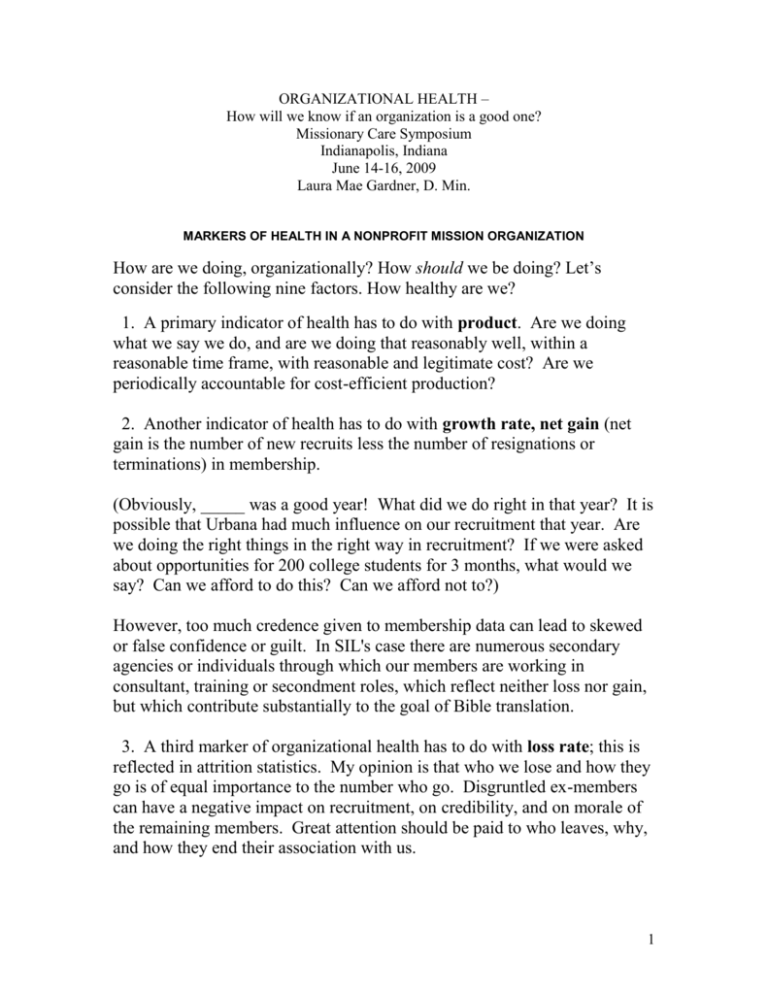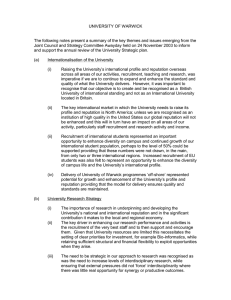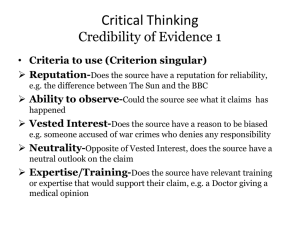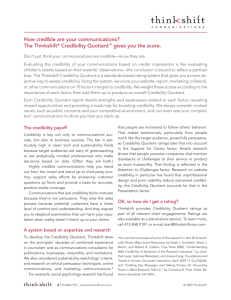ORGANIZATIONAL HEALTH – How will we know if an organization
advertisement

ORGANIZATIONAL HEALTH – How will we know if an organization is a good one? Missionary Care Symposium Indianapolis, Indiana June 14-16, 2009 Laura Mae Gardner, D. Min. MARKERS OF HEALTH IN A NONPROFIT MISSION ORGANIZATION How are we doing, organizationally? How should we be doing? Let’s consider the following nine factors. How healthy are we? 1. A primary indicator of health has to do with product. Are we doing what we say we do, and are we doing that reasonably well, within a reasonable time frame, with reasonable and legitimate cost? Are we periodically accountable for cost-efficient production? 2. Another indicator of health has to do with growth rate, net gain (net gain is the number of new recruits less the number of resignations or terminations) in membership. (Obviously, _____ was a good year! What did we do right in that year? It is possible that Urbana had much influence on our recruitment that year. Are we doing the right things in the right way in recruitment? If we were asked about opportunities for 200 college students for 3 months, what would we say? Can we afford to do this? Can we afford not to?) However, too much credence given to membership data can lead to skewed or false confidence or guilt. In SIL's case there are numerous secondary agencies or individuals through which our members are working in consultant, training or secondment roles, which reflect neither loss nor gain, but which contribute substantially to the goal of Bible translation. 3. A third marker of organizational health has to do with loss rate; this is reflected in attrition statistics. My opinion is that who we lose and how they go is of equal importance to the number who go. Disgruntled ex-members can have a negative impact on recruitment, on credibility, and on morale of the remaining members. Great attention should be paid to who leaves, why, and how they end their association with us. 1 4. A fourth marker of health in an organization is external credibility, reputation. What is said about us? How are we known? Is our organization broadly enough known to have a reputation? How do we find out what our reputation is? Are we as mission organizations paying sufficient attention to our credibility ratings in Christian communities? 5. A fifth factor of health or non-health has to do with fiscal matters. Are we sound, financially? Do we have regular audits? Do we enlist the services of a CPA to ensure that our handling of funds is above-board, and wise? Do we have skillful people working at all levels of financial responsibility? Do we belong to the ECFA, and meet their standards of ethical money management? 6. The sixth marker of health has to do with internal credibility--morale of the membership. How do the members feel about this task, doing this task with these colleagues in this organization? If indeed we believe--as appears to be true--that current members in their informal relationships constitute the best recruiters, then what the average member feels about his/her task, role, and relationships becomes extremely significant. I believe that too little weight has been given to member morale. Much emphasis is given to the task, and much to the recipients of our product, but too little to the 'community of taskers'--we need not only communion with God, and communication with leadership, but also a sense of community with one another that provides the support structures at the interpersonal level. People needs--attentive and administrative oversight, friendship, care during crisis situations, and during developmental stages of life -must be met if people are to feel worthwhile. An organization’s assessment of care structures should ask: is this care empowering or weakening our members? And, are we indeed meeting our members’ real needs? Member care is becoming an increasing challenge for our organization, as the day of big centers is over and we consider how to deliver the advantages of a center to people who live in isolated, remote and sometimes hostile settings. Making extravagant promises to 'take care of you' can lead to anger and disillusionment when a new member finds out that it doesn't happen. And 2 we must admit that total care can't happen in every situation--not all member needs can be met. 7. Philosophy of change. How much change happens, and how are these changes decided? Does the organization hold tightly to old ways of doing things, or do they monitor trends and plan proactively? How much attention is given to their members during times of change? Have they had a voice in that change? Have they had help to implement the results of that change? Who makes these decisions? 8. Posture on staff care and development. Are people in this organization viewed as producers, and only producers? Or are they viewed as valued and respected colleagues, made in the image of God, deserving of good leadership, good care? Do their gifts matter? Are there regular opportunities for growth and development? Do they receive regular feedback on their contributions, know where they are doing well, and where they should improve? 9. Are we a dynamic, living, vital organization or a dying one? Signs of life have to do with creativity, eagerness to improve, openness to new ideas. Risk is welcomed because it indicates thought and involvement. Failure is not punished. On the other hand, a dying organization is characterized by tradition, fear, doing the same things in the same way, entrenched (old) leadership, little change. Low tolerance for organizational assessment. Reflection Questions: Are there other markers of health that our organization should consider? How does our organization measure up to these indicators? Or perhaps more important: What direction is our organization going in these areas? What is a healthy rate of attrition? 3










